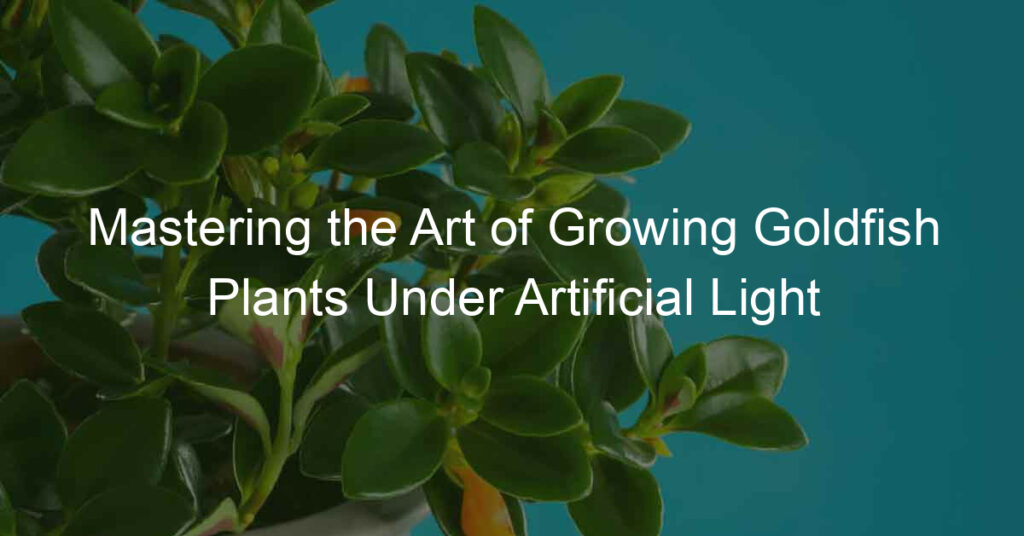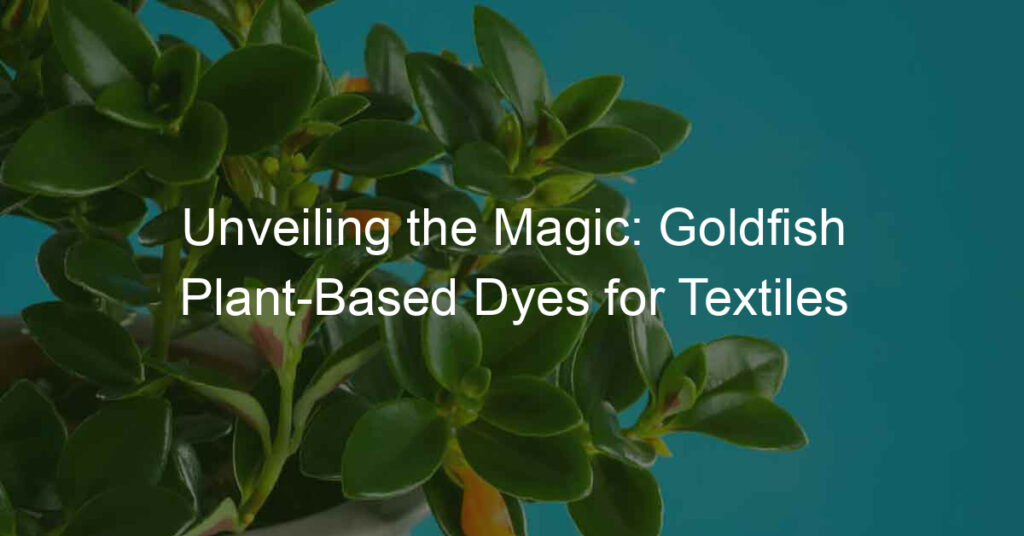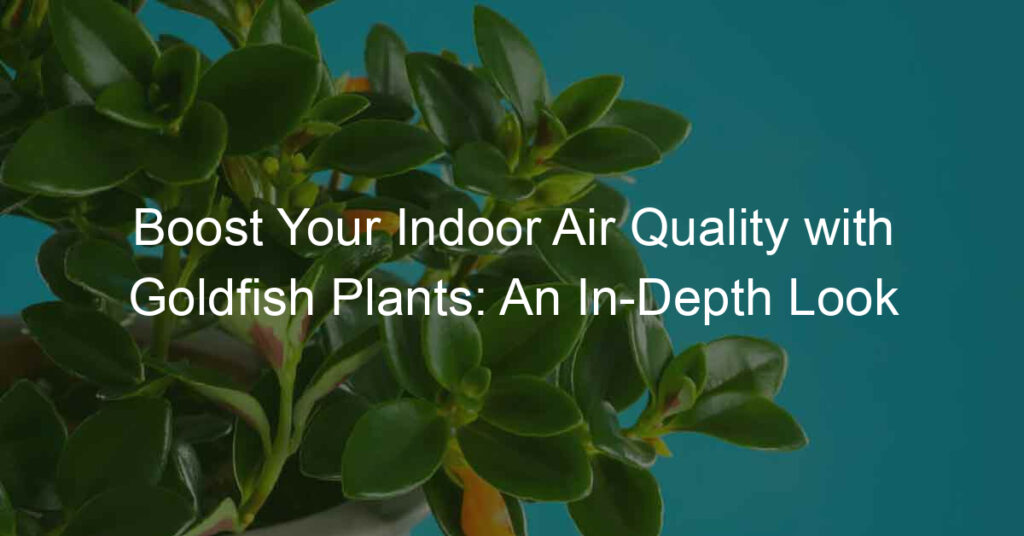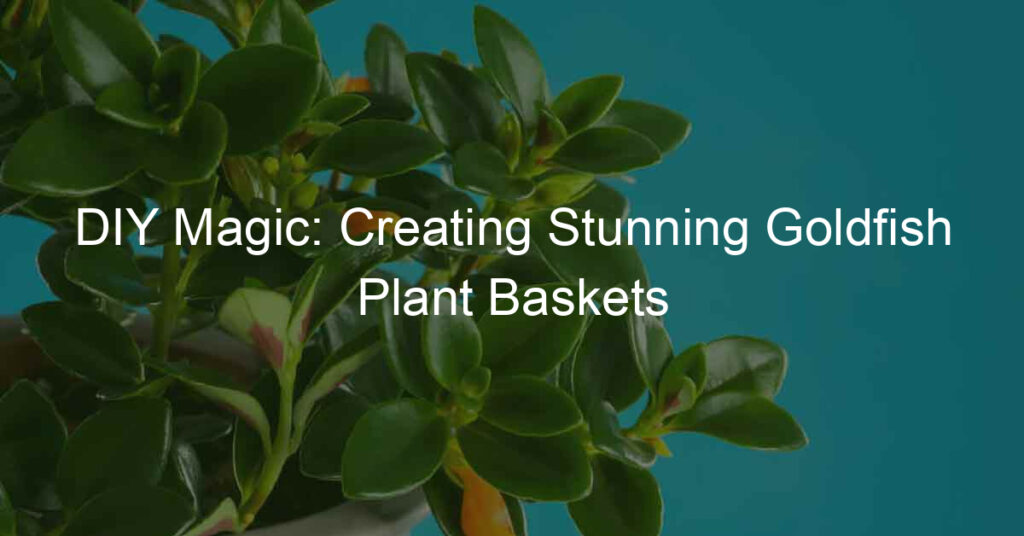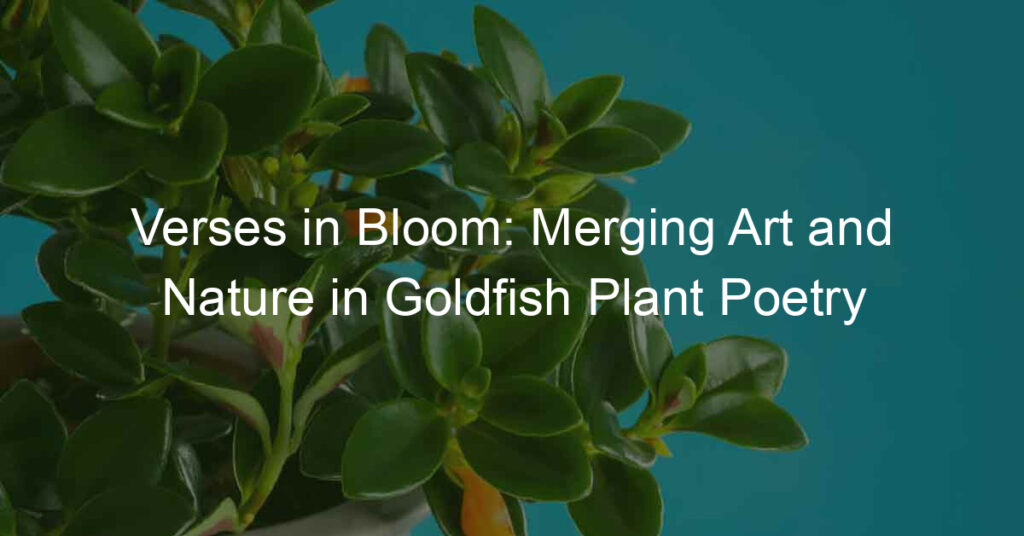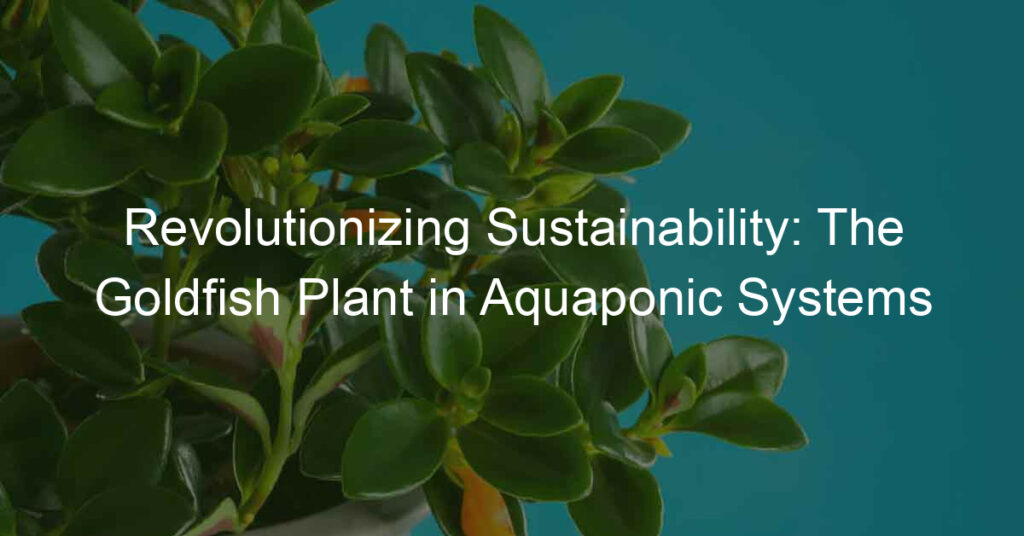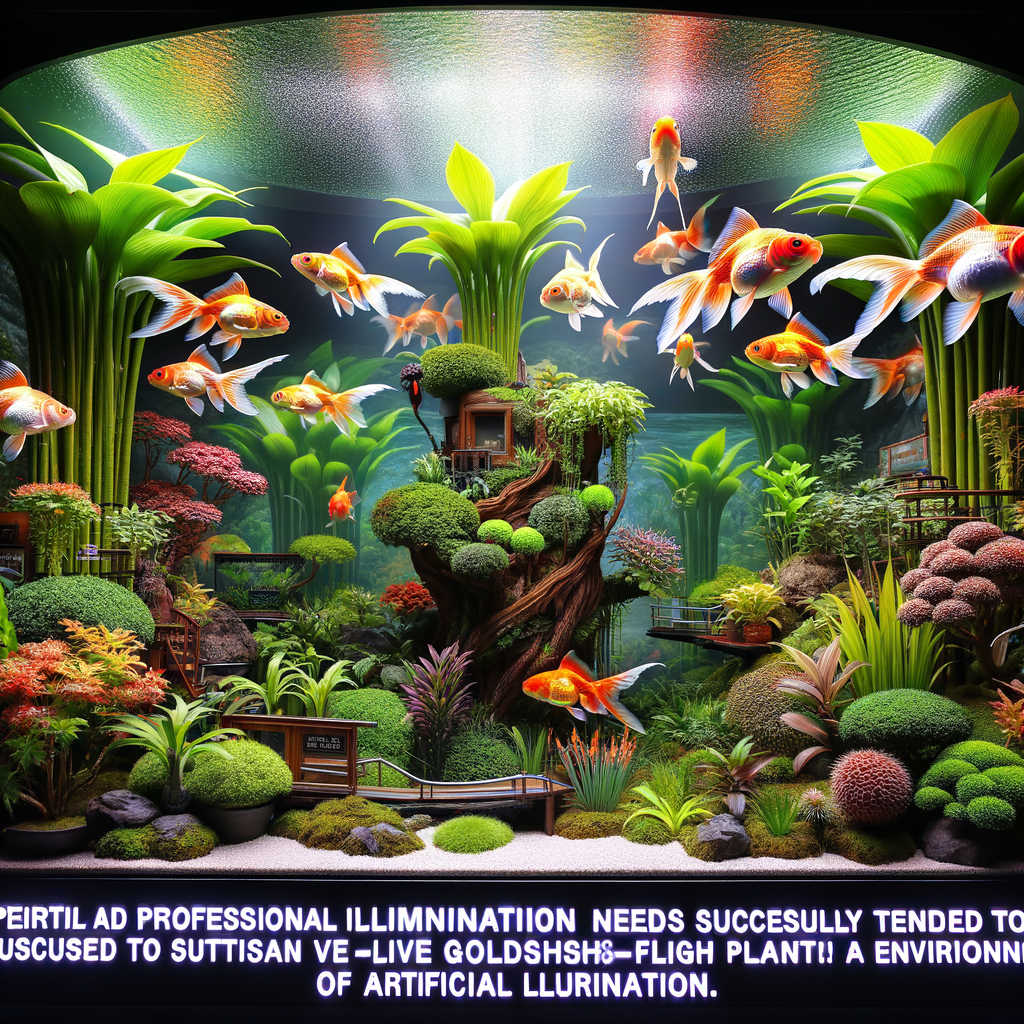
The Goldfish plant is a tropical perennial, which means it’s a plant that lives for more than two years. It’s called the Goldfish plant because its orange flowers look like tiny, swimming goldfish. The plant is a member of the Gesneriaceae family, which also includes African violets. It’s a trailing plant, meaning it grows by sending out long stems that can hang down or climb up a support.
-
- Why Grow Goldfish Plants Indoors?
Indoor gardening has a multitude of benefits, and growing Goldfish plants indoors is no exception. These plants not only add a pop of color to your living space but also have air-purifying properties. They can filter out common volatile organic compounds (VOCs) from the air, improving the indoor air quality. Additionally, taking care of plants like the Goldfish plant can be a rewarding hobby, promoting mindfulness and relaxation.
In the following sections, we will delve deeper into the specifics of Goldfish plant care, including understanding artificial light for plants, indoor care tips, common challenges, and key takeaways for mastering the art of growing Goldfish plants under artificial light.
Understanding Artificial Light for Plants
Artificial light is a crucial element in indoor gardening, especially when it comes to growing plants like the Goldfish Plant. Let’s delve into what artificial light is and how it benefits indoor gardening.
-
- What is Artificial Light?
Artificial light, as the name suggests, is the light that is not naturally sourced, like the sun. It is produced by human-made devices such as lamps, LED lights, and fluorescent bulbs. In the context of indoor gardening, artificial light is used to supplement or replace natural sunlight, providing the necessary light energy for plants to perform photosynthesis.
-
- Benefits of Artificial Light for Indoor Gardening
Artificial light offers several benefits for indoor gardening. Here are a few key advantages:
-
- Controlled Environment: With artificial light, you can control the intensity, duration, and even the color of the light. This allows you to create an optimal environment for your plants’ growth.
- Year-Round Gardening: Artificial light allows you to grow plants indoors all year round, regardless of the season or weather outside.
- Improved Plant Health: Properly used artificial light can lead to healthier plants with better growth and blooming.
In the following sections, we will explore how to use artificial light effectively for indoor care of Goldfish Plants, including a case study on growing these plants under artificial light.
Goldfish Plants Indoor Care
Indoor care for Goldfish plants can be a rewarding experience when done right. A key aspect of this care involves understanding and meeting the light requirements of these beautiful plants.
Goldfish Plants Light Requirements
Goldfish plants thrive under specific light conditions. Let’s delve into understanding these requirements and how to choose the right artificial light for your indoor Goldfish plants.
-
- Understanding the Light Needs of Goldfish Plants
Goldfish plants, also known as Columnea Gloriosa, are tropical plants that love bright, indirect light. They originate from the rainforests of Central and South America, where they grow under the canopy of larger trees. This means they are used to receiving filtered sunlight rather than direct, harsh rays. In indoor settings, a north or east-facing window is ideal. They need about 10-12 hours of light each day for optimal growth.
-
- Choosing the Right Artificial Light for Goldfish Plants
If your home doesn’t provide enough natural light, don’t worry! You can supplement with artificial light. Fluorescent lights are a great choice for Goldfish plants. They provide the right spectrum of light that these plants need without the heat that can damage them. LED lights can also work, but make sure they are specifically designed for plant growth. The light should be positioned about 12-18 inches above the plant and left on for 10-12 hours a day.
Remember, Goldfish plants are a bit like Goldilocks – they need their light conditions to be just right. Too little light, and they won’t produce their unique, vibrant flowers. Too much direct light, and their leaves can get scorched. Finding the right balance is key to successful Goldfish plant indoor care.
Nurturing Goldfish Plants in Artificial Light
Goldfish plants thrive under the right lighting conditions. Artificial light can provide these conditions when natural light is insufficient. Here, we will explore how to set up and maintain the ideal artificial light environment for your goldfish plants.
-
- Setting Up Your Artificial Light Environment
Setting up an artificial light environment for your goldfish plants is a straightforward process. Start by choosing the right type of light. Fluorescent lights are a popular choice because they emit a spectrum of light that plants can use for photosynthesis. LED lights are also a good option as they are energy-efficient and long-lasting.
Next, position your light source about 12-18 inches above your plants. This distance ensures that your plants get enough light without getting scorched. Remember, the goal is to mimic natural sunlight as closely as possible.
-
- Maintaining the Ideal Light Conditions
Maintaining the ideal light conditions for your goldfish plants involves monitoring and adjusting the light intensity and duration. Goldfish plants require about 12-16 hours of light per day. A simple way to ensure this is by using a timer to automatically turn your lights on and off.
Monitor your plants for signs of too much or too little light. If your plants’ leaves start to yellow or brown, they may be getting too much light. On the other hand, if your plants are not flowering or their growth is stunted, they may not be getting enough light. Adjust your light setup accordingly to ensure your plants thrive.
In conclusion, nurturing goldfish plants under artificial light involves setting up the right light environment and maintaining ideal light conditions. With the right care, your goldfish plants can flourish even in the absence of natural sunlight.
Case Study: Growing Goldfish Plants Under Artificial Light
Let’s dive into a real-life example of growing goldfish plants under artificial light. This case study will guide you through the steps of planning an indoor garden, choosing and setting up artificial light, monitoring and adjusting light conditions, and sharing the results and learnings.
- Planning the Indoor Garden
Before we start, it’s crucial to plan the indoor garden. We selected a space with enough room for the plants to grow and ensured that the temperature was suitable for goldfish plants, which is around 65-75 degrees Fahrenheit. We also made sure to have a proper drainage system in place to prevent waterlogging.
- Choosing and Setting Up the Artificial Light
Next, we selected an artificial light source. We chose a full-spectrum LED grow light, which mimics natural sunlight and provides the plants with the necessary red and blue light. We placed the light about 12 inches above the plants and set it to be on for 14 hours a day, simulating a long summer day.
- Monitoring and Adjusting Light Conditions
Monitoring and adjusting the light conditions was a crucial part of our process. We regularly checked the plants’ health and growth. If we noticed that the leaves were turning yellow or brown, we adjusted the light intensity or duration. We also used a light meter to ensure the plants were getting the right amount of light.
- Results and Learnings
After several months, we were thrilled to see our goldfish plants thriving under the artificial light. They grew lush and produced vibrant, orange flowers. We learned that with the right planning, light setup, and monitoring, it’s entirely possible to grow healthy goldfish plants indoors.
| Key Takeaways |
|---|
| Planning the indoor garden is a crucial first step. |
| Choosing a full-spectrum LED light can mimic natural sunlight. |
| Regular monitoring and adjusting of light conditions can ensure plant health. |
| With the right conditions, goldfish plants can thrive indoors. |
In conclusion, growing goldfish plants under artificial light can be a rewarding experience. With careful planning, the right light setup, and regular monitoring, you too can enjoy the beauty of these plants in your indoor garden.
Common Challenges in Goldfish Plants Indoor Care
Goldfish plants are beautiful and vibrant, but they can also be a bit tricky to care for indoors. There are several common challenges that you might face when trying to grow these plants at home. But don’t worry, we’re here to help you identify these problems and provide solutions and preventive measures.
- Identifying Common Problems
Goldfish plants are generally hardy, but they can still suffer from a few common problems. Here are some of the most common issues you might encounter:
- Yellowing Leaves: This is often a sign of overwatering. If the leaves of your goldfish plant are turning yellow, try reducing the amount of water you give it.
- Wilting: If your plant is wilting, it might not be getting enough light. Try moving it to a brighter location.
- Slow Growth: Goldfish plants need a lot of nutrients to grow. If your plant is growing slowly, it might need more fertilizer.
- Solutions and Preventive Measures
Now that we’ve identified some common problems, let’s talk about how to solve them and prevent them from happening in the first place.
- Prevent Yellowing Leaves: Make sure you’re not overwatering your plant. Goldfish plants like to dry out a bit between waterings, so make sure the top inch of soil is dry before you water again.
- Prevent Wilting: Make sure your plant is getting enough light. Goldfish plants need bright, indirect light to thrive. If you don’t have a bright window, consider getting a grow light.
- Prevent Slow Growth: Feed your plant regularly with a balanced fertilizer. This will provide it with the nutrients it needs to grow.
Remember, every plant is unique and might require slightly different care. Pay attention to your goldfish plant’s needs and adjust your care routine as necessary. With a little bit of patience and care, your goldfish plant can thrive indoors.
Key Takeaways on Mastering the Art of Growing Goldfish Plants Under Artificial Light
As we conclude our exploration into the world of goldfish plants and artificial light, let’s recap the main points we’ve learned. These key takeaways will guide you in mastering the art of growing these vibrant plants under artificial light.
Understanding the Importance of Light in Plant Growth
Light is a critical factor in plant growth. It’s not just about providing light, but the right kind of light. Goldfish plants, like all green plants, use light to make food through a process called photosynthesis. Without enough light, your goldfish plant may struggle to grow and bloom.
-
- Choosing the Right Artificial Light
Not all artificial lights are created equal. Fluorescent lights, especially those designed for plant growth, are often the best choice for indoor plants. They provide a good balance of red and blue light, which are essential for photosynthesis and plant growth. LED lights can also be a good choice, especially if you’re looking for energy efficiency.
-
- Creating and Maintaining the Ideal Light Environment
Creating the right light environment involves more than just turning on a light. You’ll need to consider factors like light intensity, duration, and even the distance between the light source and the plant. Remember, too much light can be just as harmful as too little. Aim for a balance that encourages healthy growth without causing stress to the plant.
-
- Overcoming Common Challenges
Even with the right light, you may encounter challenges. Some common issues include yellowing leaves, slow growth, and lack of blooms. Often, these problems can be solved by adjusting the light conditions. For example, if your plant isn’t blooming, it may need more light. If the leaves are yellowing, it may be getting too much light.
By understanding the importance of light in plant growth, choosing the right artificial light, creating and maintaining the ideal light environment, and overcoming common challenges, you’ll be well on your way to mastering the art of growing goldfish plants under artificial light.
| Key Takeaway | Description |
|---|---|
| Importance of Light | Light is crucial for photosynthesis and plant growth. |
| Choosing Artificial Light | Fluorescent and LED lights are often the best choices for indoor plants. |
| Creating Ideal Light Environment | Consider factors like light intensity, duration, and distance from the plant. |
| Overcoming Challenges | Common issues like yellowing leaves and lack of blooms can often be solved by adjusting light conditions. |

